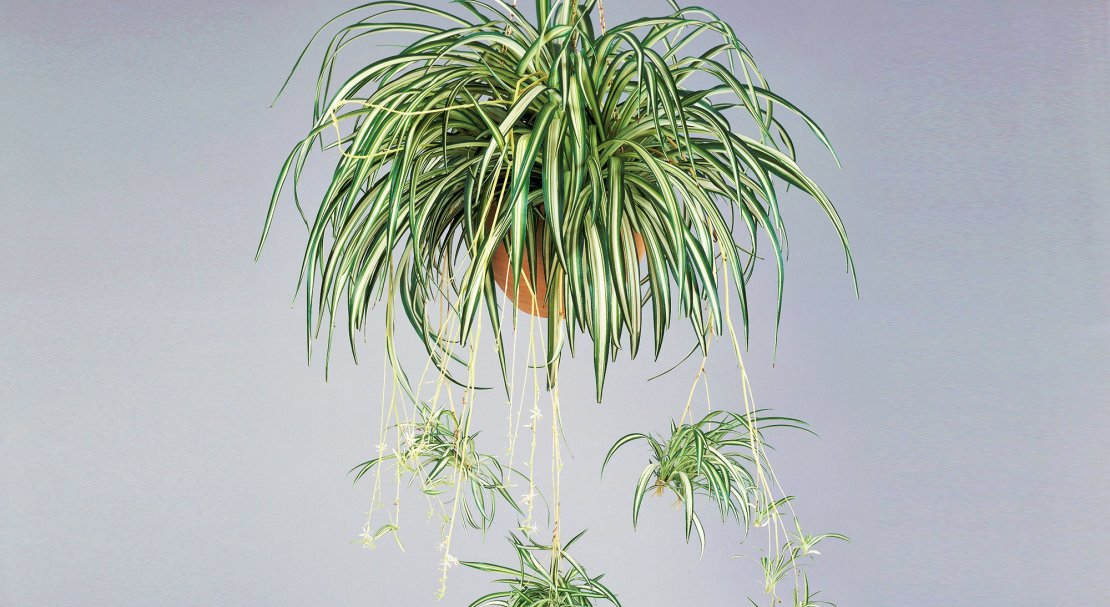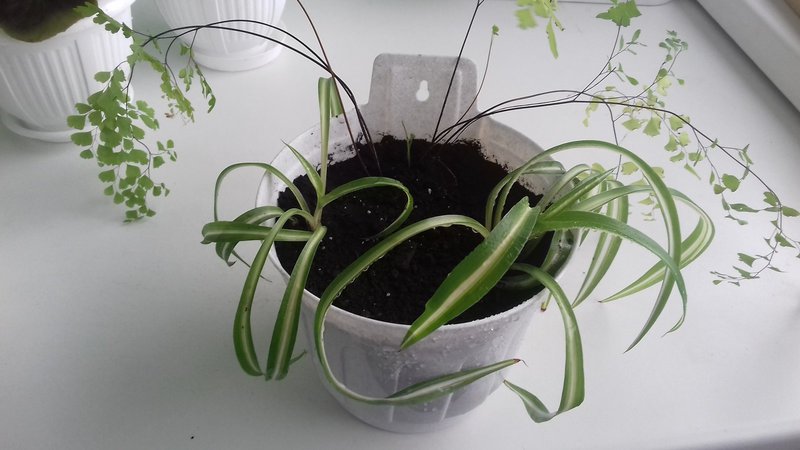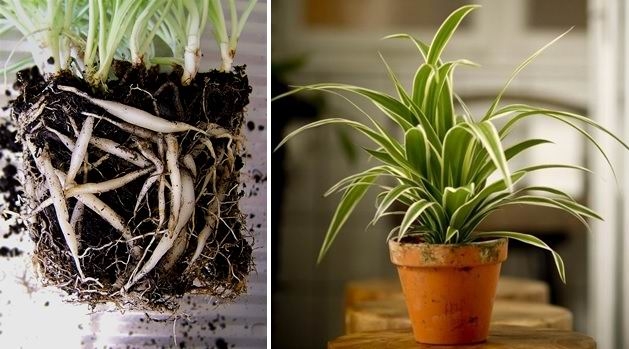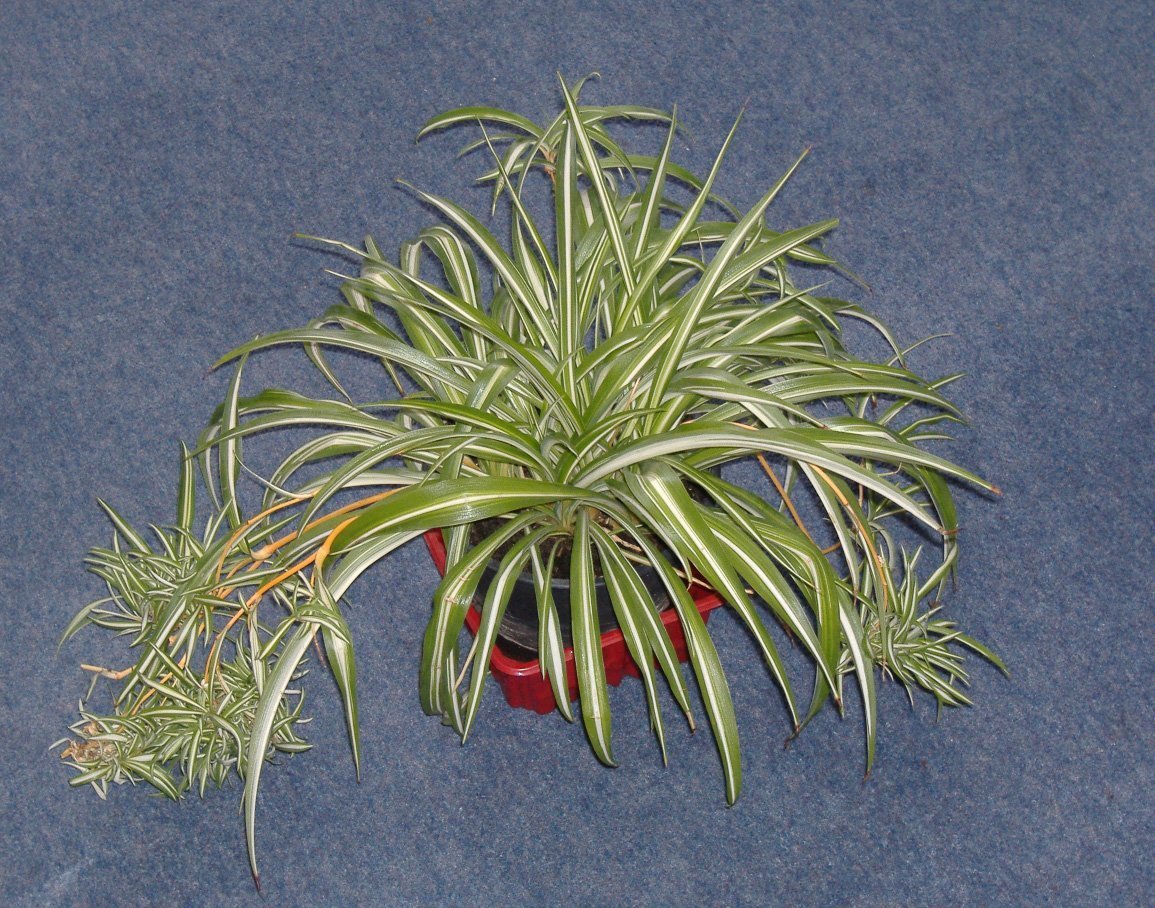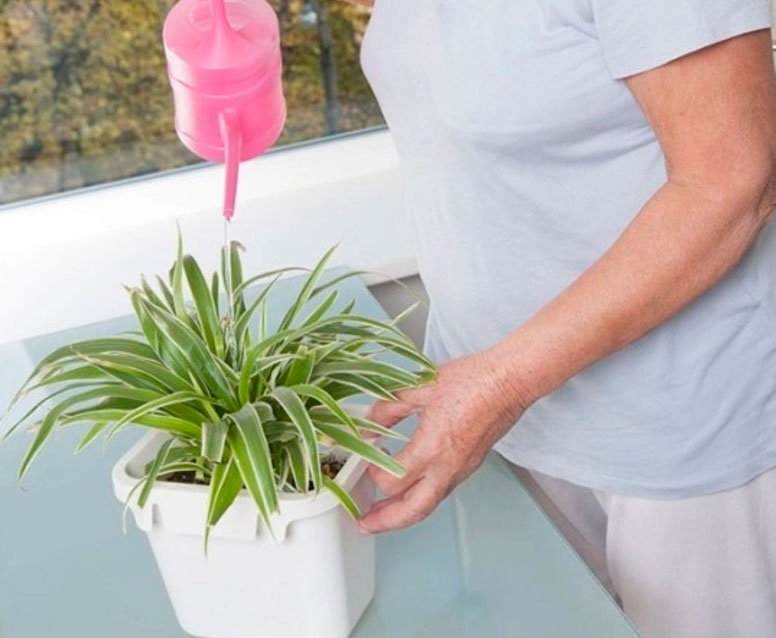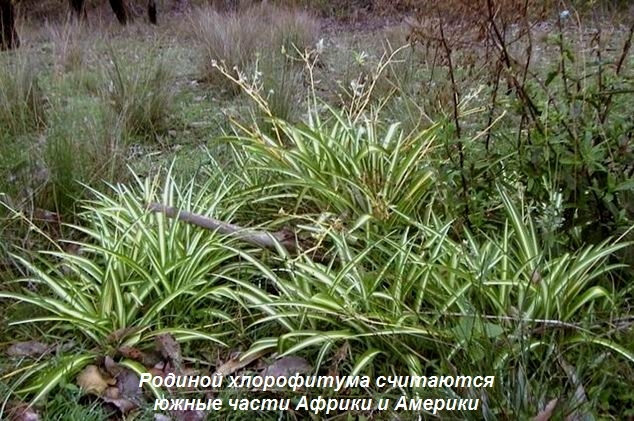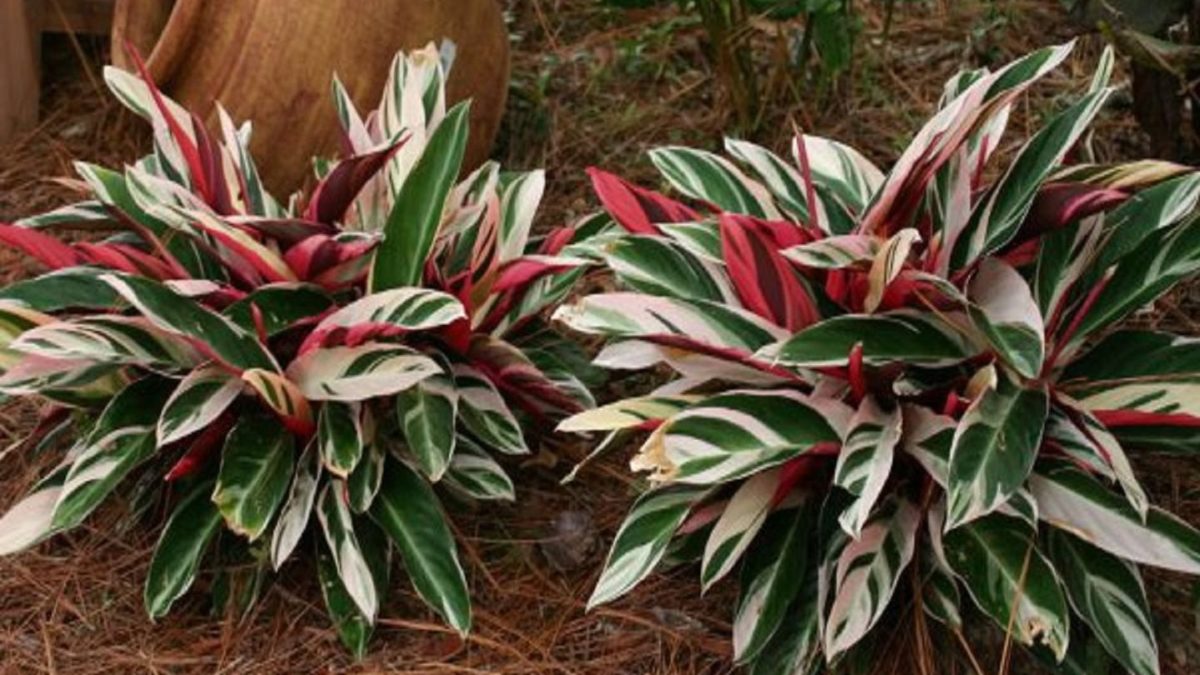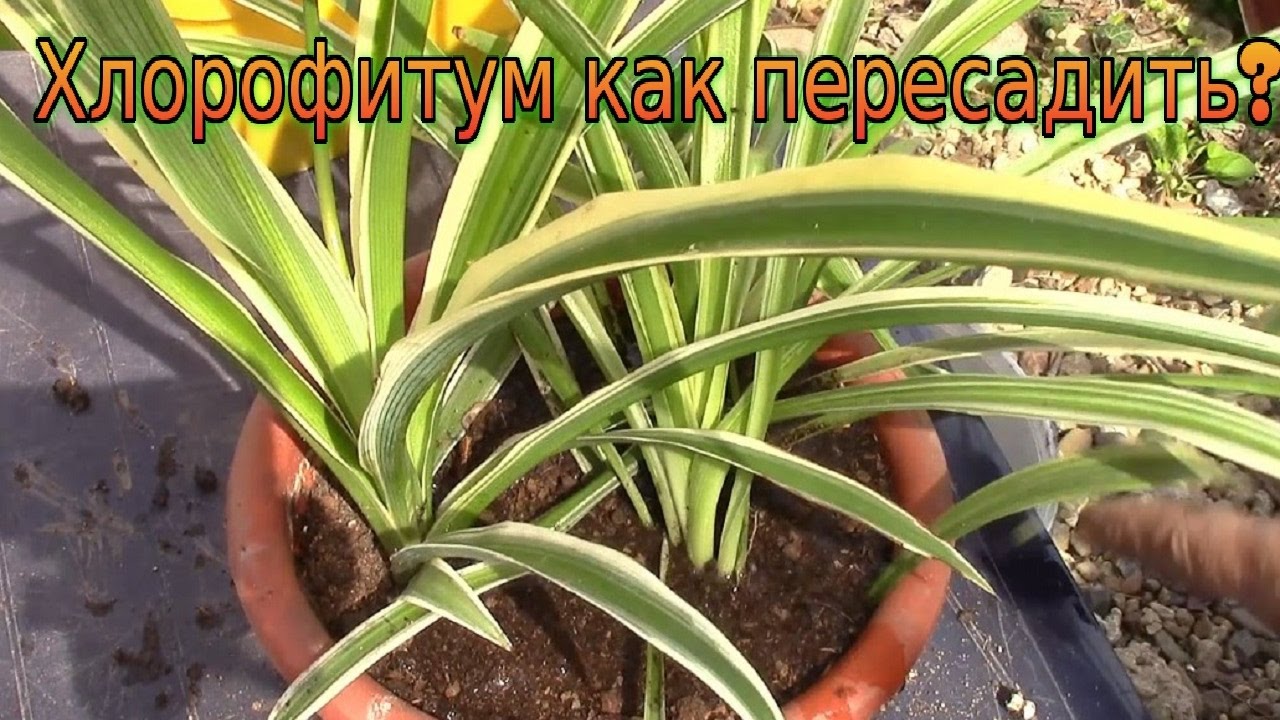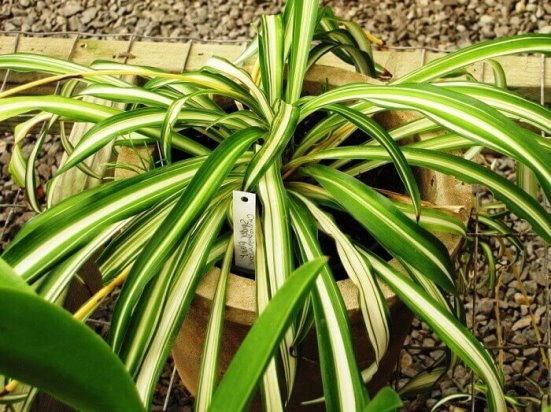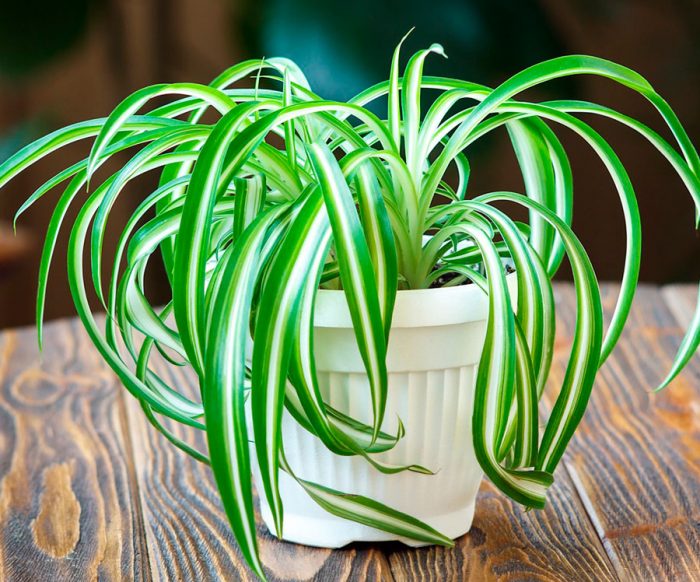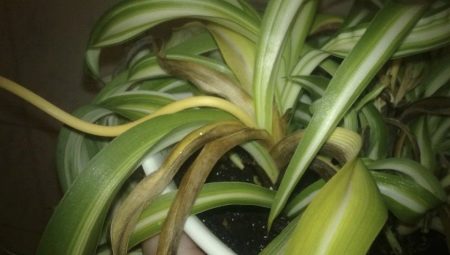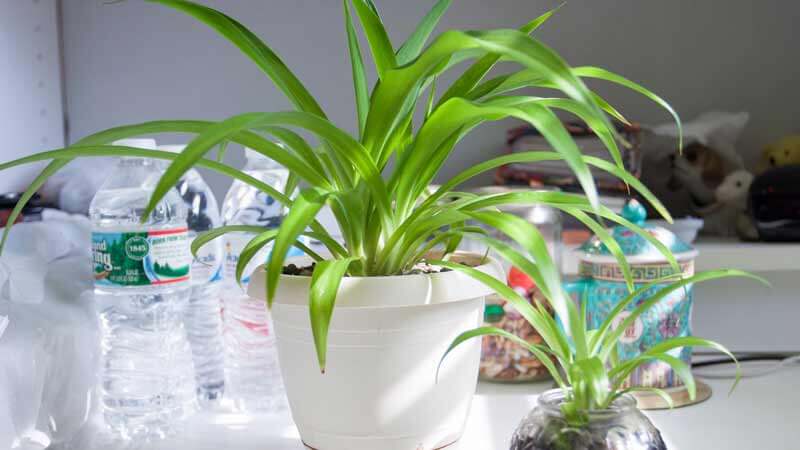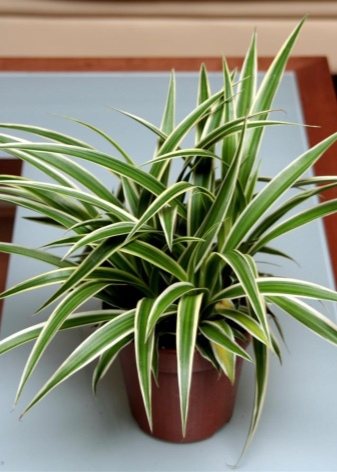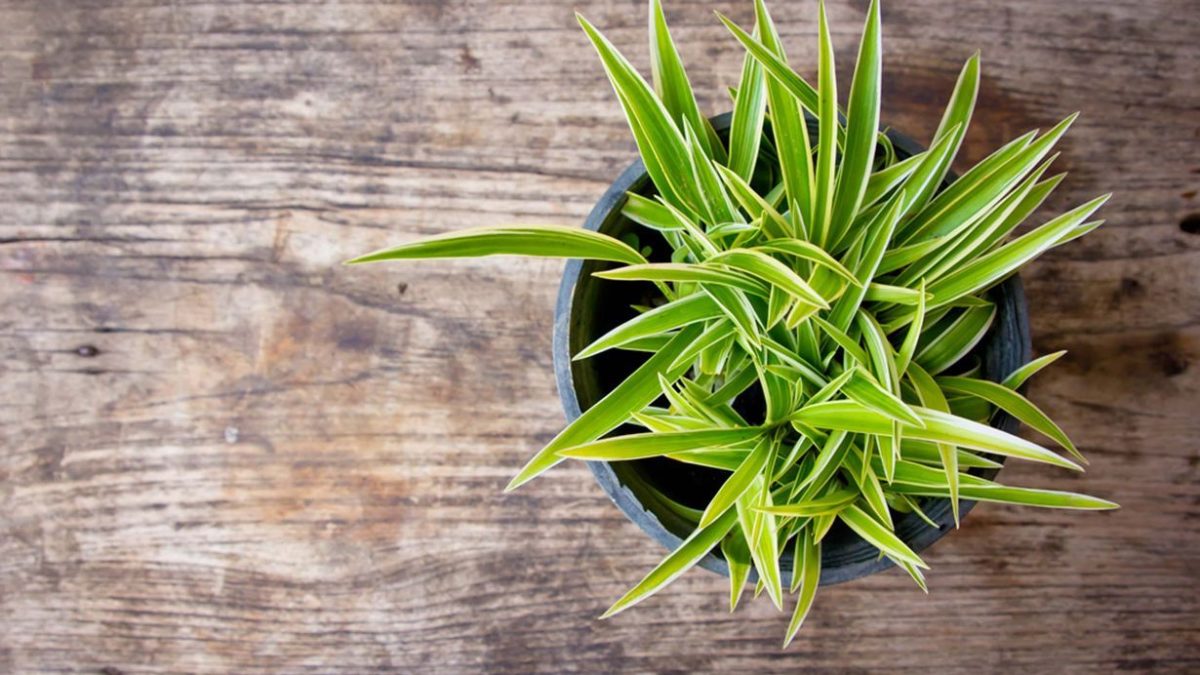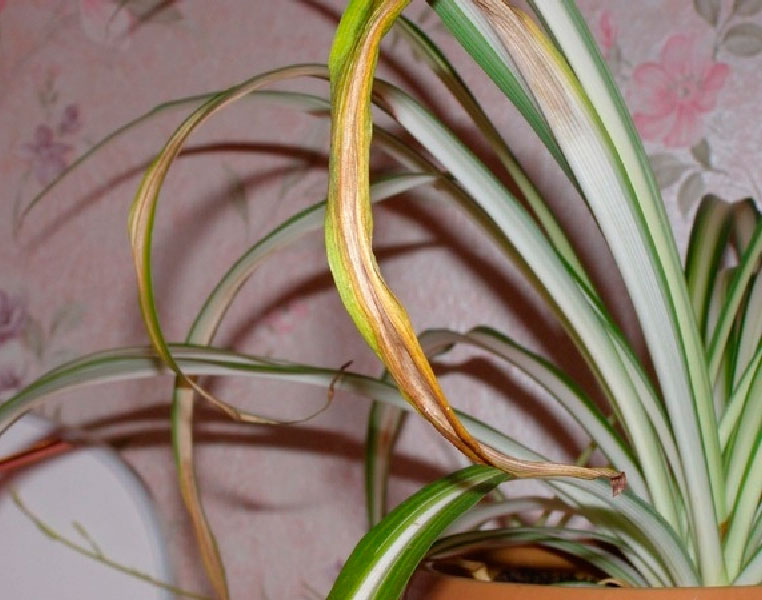Reproduction methods
Breeding method
Chlorophytum propagation is not a problem. Most varieties have excellent dividing ability. Various methods are suitable for these purposes. The "green lily" reproduces:
- seeds;
- dividing the bush;
- sheet socket.
In practice, it is preferable to grow your favorite variety by dividing the bush or using "children", since the seed method is longer and more laborious.
Sowing with seeds
Planting seeds
The seeds are sown in March. The algorithm of actions is as follows:
- Seeds are soaked in water for a day
- Prepare in advance a mixture of sand and peat (1: 1), which is filled with a container for planting
- Seed material is laid out on the surface, slightly pressing against the ground
- The container is covered with film or glass, creating a mini greenhouse
- Germination is carried out in a warm, moderately shaded place.
- The greenhouse is regularly ventilated, and the soil is moistened
- Seedlings appear in a month,% germination depends on the quality of the seeds
- The pick is carried out in the phase of 2-3 true leaves
After flowering, a green box with seeds is formed on the aerial shoot. Then it becomes transparent, and the seeds become black, ripe. They are used for sowing.
Dividing the bush
Dividing a bush is an easy way to save money, and even if you want to make money on your plants.
Reproduction of chlorophytum by a similar method is convenient to carry out during the transplantation period. An adult plant is used at the age of 4-5 years. Step-by-step instruction:
- Before transplanting, the bush is watered abundantly
- Remove their pot and divide it into several parts, being careful not to damage the roots.
- Each "section" must have roots and a leaf outlet
- On small plants, damaged roots and dry leaves are removed
- Planted in separate containers
As it grows, it is transplanted into a larger pot every year. This method is applicable for all types of chlorophytums. It makes it possible to quickly get an adult plant. A photo of chlorophytums proves that they quickly grow after division.
Young plants propagated by dividing the bush
When dividing an adult bush into several parts, injuries to the roots or rosette of leaves are inevitable. It is an excellent breeding ground for microorganisms. The cuts will dry better if sprinkled with crushed charcoal.
Leaf rosette
Rooting "kids" and cuttings is the easiest way to reproduce
After flowering, rosettes of leaves appear on the hanging shoots, which can be planted for subsequent rooting. Pruning is carried out from the mother bush, placed in water and waited for about a week to root. Then young bushes are seated in cups. They take root well and quickly gain green mass.
Chlorophytum is easy to propagate by cuttings and layering. In the first case, part of the shoot with a rosette is placed in water and rooted. In the second, the rosette of leaves is not separated from the mother liquor with a knife, but is planted in the ground. When the bush grows up, chlorophytum is pruned, separating it from the mother's shoot. New plants should be planted in small pots.
Care rules and additional, useful information about the "spider flower" are presented in the video:
CHLOROPHYTUM care beneficial properties WHY LEAVES TURN YELLOW
Chlorophytum home (120 Photos) - home care, reproduction, transplant, disease + Reviews
How to make a planter for flowers with your own hands: outdoor, for the house, hanging | Step by Step Diagrams (120+ Original Photo Ideas & Videos)
Main varieties
There are several types of this plant. Each of them has characteristic features.
Crested
Chlorophytum crested is a variety that is more common than others. This variety is recognized by the presence of a branched rosette, from the center of which leaves of green color with a pronounced clarified middle or light, almost creamy edges depart.
Kapsky
The difference between this variety is wide, but long leaves. They stretch up to 60 centimeters. Cape chlorophytum is grown in hanging pots.
Orange
The central vein of leaves and petioles have a pronounced orange tint. This plant is characterized by an elongation of the stem up to 30-40 centimeters.
Laxum
Compact variety with a small leaf rosette. The leaf plates at the edges acquire a pale, almost white, shade.

Borilianum
A variety that is recognized by the wavy edge of each leaf. The leaves are colored with an attractive emerald green shade.
Possible plant diseases
For all its unpretentiousness, chlorophytum, of course, is susceptible to disease. However, with proper care, providing timely assistance, they can be easily dealt with.
Aphids and mites. It is necessary to treat the plant with special medicinal products. If it is problematic to purchase a special product, ordinary soap solution prepared on the basis of laundry soap will save you. Each leaf of the plant must be washed with this liquid.
Mealybug. The first symptom of the disease is that the plant actively sheds foliage. In such an unpleasant situation, special preparations are needed. To prevent disease, watering should be controlled and excess moisture should be avoided.
Shield. The first symptom of the disease is yellow leaves. It is necessary to treat the bush with vodka, and then treat the crown of the bush with a special agent.
Diseases and pests
Chlorophytum is not very susceptible to disease and pests. With improper care, it can become infected with scale insects and aphids. In this case, you need to wash the plant with soapy water and treat it with an insecticide.
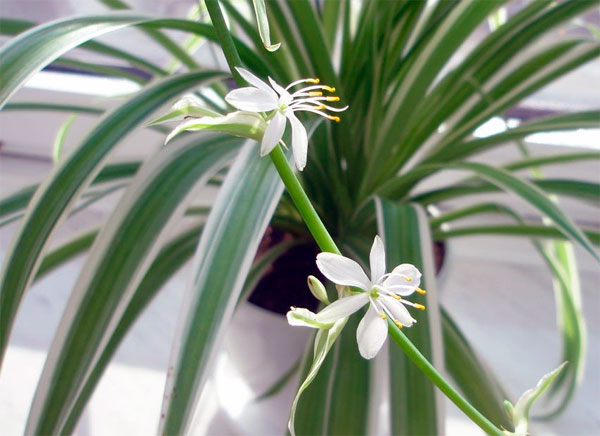
Possible difficulties in growing chlorophytum:
- What to do if the tips of the leaves dry and turn yellow? This may indicate too low air humidity, you need to increase the number of sprays;
- Do not worry too much if the leaves of chlorophytum turn yellow and dry. For this flower, as for many herbaceous plants, leaf dieback is a natural process. If chlorophytum turns yellow and dries more than usual, then the room is too dry or too weak lighting. It is necessary to increase watering and spraying and move the plant to a brighter room. Dry leaves should be trimmed regularly;
- If the tips of the leaves of chlorophytum turn black, then this may indicate a lack of nutrients or the room temperature is too high and the air humidity is too low. It is necessary to revise the conditions for keeping the plant;
- If chlorophyllum is not growing, then most likely the plant is planted in too large a container. It will not actively grow until the roots encircle the entire earthy clod. You can transplant chlorophytum into a smaller pot or increase the feeding with fertilizer with a high nitrogen content, which contributes to the active growth of green mass;
- There is no flowering. Chlorophytum stops blooming in a very cramped pot. In this case, the plant should be transplanted into a large container.
Usually, with proper care, chlorophytum grows healthy and beautiful - a real "green plant", but sometimes it is attacked by diseases and pests. The flower will announce the problem by changing its appearance:
- the leaves of chlorophytum turn yellow - root rot from the fungus (if the root is completely blackened, the plant cannot be saved; if insignificant areas are affected, they are removed, the cut points are sprinkled with coal powder, transplanted into new soil and do not watered for several days, keeping in the shade);
- brown tips of chlorophytum leaves - lack of nutrients or high temperature in the room (feed, rearrange to a cool place, ventilate);
- brown stripes on the leaves of chlorophytum in winter - excess moisture (you can dry the roots, transplant the flower into new soil, do not water for several days; adjust watering);
- twisted leaves with yellow-brown spots, brown edges of chlorophytum leaves - a large moisture deficit (water abundantly, adjust watering);
- chlorophytum grows slowly - lack of nutrients, little light (feed, rearrange to a brighter place, turn on the phytolamp);
- chlorophytum does not form children - a cramped pot or an immaturity of a flower (transplant into a more spacious pot);
- chlorophytum leaves turn pale - little light or lack of nitrogen (rearrange to a brighter place, feed);
- rots in the center - excess moisture (dry the roots of the flower, transplant into new soil, do not water for several days, then adjust the watering);
- the leaves have become soft - the plant is cold (rearrange to a warm place);
- light brown dry spots on the leaves - sunburn (shade);
- dry tips of leaves - dry air indoors (spray, put on a pallet with moistened expanded clay);
- chlorophytum begins to fall on its side - the bush has grown too much (divided into fragments and transplanted);
- leaves turn black in summer - little moisture, dry air (water abundantly, spray, put on a pallet with wet expanded clay).
Signs and superstitions associated with chlorophytum
Belief in the magical properties of chlorophytum speaks of the observed properties of the plant to help people in different areas of life.
Famous superstitions about the benefits of the chlorophytum flower read:
- It is recommended to enter a new home with chlorophytum in order to create a positive atmosphere and fill the place with coziness. It will be easier to take root in a new environment with this indoor plant.
- It is believed that the plant withers and loses its useful properties in the house, where they constantly quarrel and swear, a negative atmosphere and negative energy reign. It serves as an indicator and suggests when relationships with household members become aggravated and the time has come to try to improve them.
- Chlorophytum is called "bride's veil" for the similarity of flowers to wedding decorations. It is acquired by lonely people to find love and family happiness. The plant will help in strengthening existing relationships, make them stronger and more trusting.
- A good omen is considered to be the sprouting of the flower. If there are more than 20 - 30 of them, it means that the person will be successful: his material condition will improve, and bright joyful moments will appear in his life.
What does chlorophytum orange look like, which family does it belong to?
Herbaceous perennial is distinguished by a variegated emerald hue, wide leaves are pointed, glossy. Closer to the base, they significantly narrow, reach 25-30 cm in length, 5-10 cm in width, the edges are slightly wavy. Growing from the center of the basal rosette on elongated petioles, the leaves hang down in a lush cascade in different directions. The total plant height reaches 45-60 cm in natural conditions and 25-30 cm in containers at home. The root system is tuberous and strong enough. The stem is shortened, the lateral shoots bloom over time. The smell of chlorophytum is pleasant, soothing. The flowers on the plant are arranged spirally.

Chlorophytum orange
Additional Information! Chlorophytum orange has other names: winged, orchidostellar and orchidastrum. This is due to the specifics of the structure of the leaves and the shade of the petioles (pale pink or orange).
The bush is classified as a member of the Asparagus family, the homeland of the flower is South Africa. The plant is perennial, lives on average 10 years.
Chlorophytum care at home
A viable and unpretentious flower is suitable for breeding both for beginners and experienced plant breeders. A pot or flowerpot is placed in any free place - a light window sill, a hook on the wall in a dark corner - the culture can withstand different conditions.
Indoor chlorophytum survives with irregular watering, and if the soil becomes scarce or a pest attacked the plant, the flower will instantly let you know about the problem. Top dressing, spraying will correct the situation. The plant will quickly gain strength, will thank the owner for taking care of fresh herbs and flowers.
Lighting and temperature for chlorophytum

Loves warmth. The optimal temperature regime is from +15 C to +30 C. When the thermometer drops from +10 C, watering is stopped, in moist soil the roots will quickly die. Drafts for a flower are not fatal, but unpleasant.
Understanding how to care for the chlorophytum flower, the owners think over a permanent place.
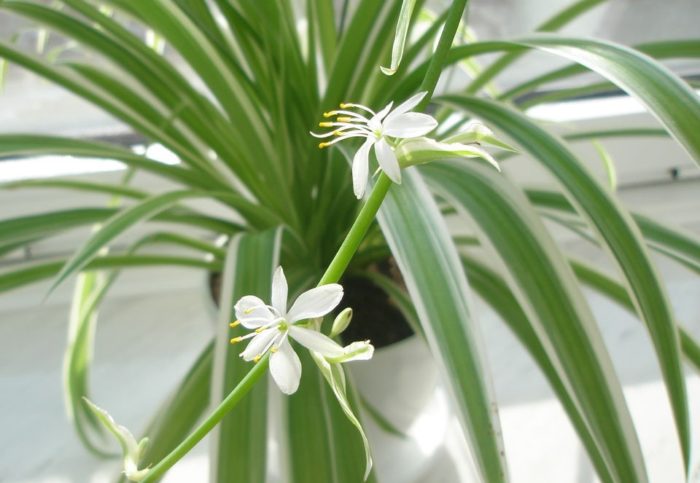
Here are some rules:
- culture will have enough scattered sunlight;
- the optimal zone is east, west (window sill);
- on the south side, during the heat of the day, the plant is shaded;
- for dark corners, varieties with green leaves are chosen;
- in winter, phytolamps are placed on variegated varieties for the brightness of the shade.
Watering and spraying
Standing tap water of any hardness is what the chlorophytum flower requires, and taking care of it at home will be easier if:
- Observe regular watering. From spring to autumn, the soil is moistened daily or every 3-4 days, but abundantly.
- In winter, watering depends on the temperature in the house. With excessive heating work, the amount of water is not reduced, if in the house it is up to +20 C, it is moistened once every 3-5 days.
The plant is sensitive to spraying, wiping the leaves
But the process is not necessary, the flower tolerates any level of air humidity.
The leaves are brittle, they are handled carefully. Having broken the leaf, they cut off the remainder of the trunk, otherwise bacteria will settle on the cut.
A moisture-loving culture does not tolerate stagnant water. The liquid remaining after watering is drained from the pan.
Chlorophytum fertilization
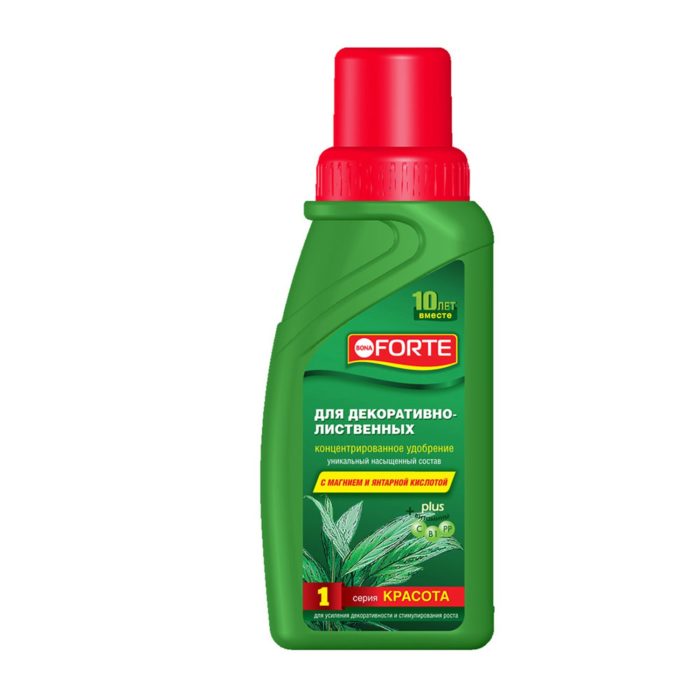
By planting a flower in a special nutritious soil for decorative deciduous plants, the owner can forget about feeding. Wanting to increase the period and splendor of flowering, from June to the end of August, the bush is fed with a growth stimulant. Ready-made mixtures are sold in flower shops, they are used strictly according to the instructions no more than twice a week. The soil collected from the nearest front garden must be fertilized. Complex fertilizers are used for home flowers. Mineral dressings are diluted according to the instructions, applied no more than 1 time in 7-10 days.
Soil composition for chlorophytum

Moisture-intensive, loose substrate - ideal soil for culture. Independently, the soil is prepared from equal parts of leaf and sod land, humus, peat, sand. A little bone meal, horn shavings will loosen the soil, make it more nutritious.
A pot or flowerpot is chosen depending on age. Adult flowers are transplanted into thick-walled ceramic, clay containers. The plastic will crack, will not withstand the powerful root system.
Chlorophytum care at home

There is no need for special care for chlorophytum: the main thing is timely watering and feeding in spring and summer. An interesting fact is that if the plant is not watered for a long time, it will still not die, but it will not say thanks either, so it is better not to experiment with the pet.
Lighting
In terms of lighting, chlorophytum is not very picky, however, a plant in the light looks much more attractive and healthier, it fades in the shade. Chlorophytum pots are kept on the sunny side, mainly in the east or west direction. Here, direct rays only for a short time fall into the windows, and the rest of the day is dominated by diffused light.
For variegated varieties, it is important to be in rooms that are most illuminated by the sun in both summer and winter. If you put the plants in partial shade, you may encounter the problem of leaf discoloration.
Temperature
The plant develops equally stably in cool and hot weather. In summer, the flower is allowed to be carried outdoors. The place should be away from drafts and protected from precipitation.In winter, the temperature in the room should not be allowed to drop below 10 degrees, otherwise the culture risks dying.
Watering mode
Indoor chlorophytum species need abundant moisture during spring and summer. Watering is carried out frequently. With a lack of water in the soil, deformation of the tuberous processes is observed. Thickening appears on the tubers. In winter, the amount of irrigation water is reduced, but the earthy clod in the flowerpot is not allowed to dry out. They also try to prevent stagnation of fluid near underground parts.
Humidity level
Chlorophytum prefer high humidity. It is not necessary to spray the leaves through a spray bottle. You can do this procedure if you have free time. As a rule, the perennial responds gratefully to the regular moisturizing of the leaves, begins to grow more actively and build up mass.
The soil

A loose and light substrate containing humus, sod and deciduous soil is suitable for growing chlorophytum. The ratio of the components is the same. Half the amount of sand is added. Drainage material is placed at the bottom so that water does not stagnate in the tubers.
Fertilization
In the summer and spring months, top dressing is applied every 2 weeks. The flower reacts positively to the introduction of mineral and organic fertilizers.
Transplant features
At an early age, the flower is often transplanted. For a year, the nodule root system grows strongly, so young bushes are transplanted into flowerpots of a larger diameter. Instances that have reached the age of 3-4 years are rarely disturbed. The procedure is scheduled for the end of February or March. The pot is selected wide and roomy.
Possible problems
Due to improper care, some problems may arise after the transplant.
- Chlorophytum leaf tips are dry and brittle. The reason for this may be a lack of water or an excess of sunlight, as well as low humidity in the room.
- The leaves of the plant began to turn black and rot. This is due to excess moisture in the soil, which is caused by frequent watering of the indoor plant.
- Chlorophytum leaves began to turn yellow. The reason was the lack of light. This plant loves well-lit rooms. With a lack of minerals, the plant can also begin to wilt. This can happen when the flower is cramped in the pot. To make sure of this, you should lift the leaves and examine the root system of the plant. It may be time to transplant the chlorophytum into a wider container.
- Delayed growth of chlorophytum. This can be caused by an incorrectly sized pot, as a large container is also not suitable. The flower will not grow until the roots fill the entire space. Growth can stop if the soil for chlorophytum is too heavy or insufficiently saturated with minerals and fertilizers.
- If the plant does not have children for a long time, it means that it is cramped in this pot or there is not enough sunlight.
- The plant does not let the whiskers that are characteristic of it. This is due to a lack of light, as well as fertilization and watering. We need to reconsider caring for him.
- Chlorophytum lost its previous color, became more faded and dull. Low lighting is the reason. Therefore, the plant must be placed on a windowsill or at least to a constant light source.
- The fragility of flower leaves appears when there is a lack of lighting or when there is an excess of fertilizers in its soil.
- If the flower begins to rot, this is due to the unsuitable air temperature (too low), which causes moisture retention in the ground.
- If the leaves of an adult flower begin to curl, it means that it needs to be fed with fertilizers and later transplanted into a freer container.
- The appearance of spots on the leaves, as well as root rot, are caused by pathogenic bacteria. It is immediately necessary to purchase a plant protection agent against fungus.
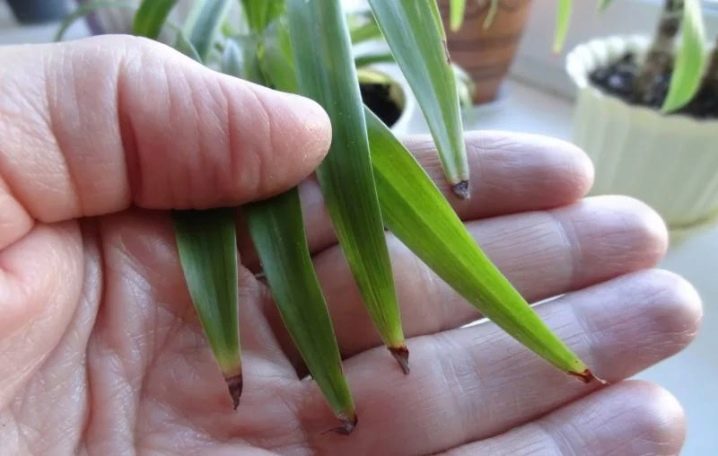
How to propagate chlorophytum with rosettes, see below.
Types and varieties
Laxum is a subspecies of crested chlorophytum. Although the cultivar is grown indoors, it often dies from improper care. As a light-demanding plant, Laxum needs to be checked daily for the quality of its shoots. The middle of each sheet is "cut" by a white stripe of gray tint. The variety is rather rare in comparison with other types of chlorophytum.
It is difficult to find this variety on sale, it is not as common as other types. However, if the grower is lucky enough to get a home plant with a white stripe in the middle of a green leaf, you need to take care of it.


"Komosum" is the same crested chlorophytum. "Komosum" attracts cats and other pets with its smell, which is why it is widely believed that the variety is dangerous to animals and can cause them poisoning. It's a lie. A certain smell only attracts cats and dogs, but it does not bring any harm to their body.
This is a small bush up to 70 centimeters in size. Due to its appearance, flower growers also gave the crested chlorophytum a beautiful nickname - "St. Bernard's lily". During the flowering period, white six-leaved flowers open. Its roots are thick and constantly accumulate moisture.
The flowering process at home is a rare occurrence. In the room by the window, the plant does not bloom due to a lack of the required temperature or lighting. For those who want to see the flowering of crested chlorophytum, it is necessary to move the plant to a greenhouse. You can also watch the variety bloom in the wild.
In the process of cultivation, which has been going on for more than 200 years on the windowsills of flower growers, crested chlorophytum has adapted to the home climate and has become resistant to various diseases.


In the process of breeding new species, a variety of crested chlorophytum appeared under the exquisite name "Ocean". It was first registered relatively recently - in mid-2002. Unlike its "parent", this plant does not start up new branches with children. The leaves have a smooth surface and light green color, as well as a length of 60 centimeters. The structure of the plant resembles a spiral, its leaves curl as they appear.
The "winged" variety is also referred to as "orange" because of its color: the veins on the leaves are cast orange. Also in the circle of flower growers it is customary to call this variety "marmalade". Leaves tend to grow up to 10 centimeters in length and gather in a tight outlet. Petioles differ from many varieties in that they have an elongated structure and a bright orange color, for which many people fell in love with this plant. The edges of the leaves are also bordered with thin orange stripes.
It is noteworthy that this variety is the only one who managed to get officially a double name - "Orchidosvezdny" is an alternative to "Winged" chlorophytum and means the same flower. The peduncle is very small in comparison with the leaves, and the flowers are arranged spirally in relation to each other.
What chlorophytums of different types look like: photos and names
The most popular are:

Chlorophytum crested (Ch. Comosum)

Chlorophytum crested "Variegatum" (Ch. Comosum "Variegatum")
Chlorophytum crested is a perennial, herbaceous, ornamental plant with a bunch of succulent thickened roots. Leaves are basal, petiolate, linear, up to 40 cm long and up to 2.5 cm wide, arcuate, collected in a rosette. Peduncles (emerging from the middle of the outlet) are rounded, up to 60 cm long (sometimes they grow up to 100 cm), at first with several flowers at the top; on the top and on the sides of the flowering shoots, young shoots develop - plants with roots, consisting of a bunch of leaves and roots. This type of chlorophytum has small branches. Hanging flower shoots. Found in South Africa.

Vittatum - with a longitudinal white stripe in the middle.

Maculatum - leaves with longitudinal yellow stripes.

Variegatum - leaves with a white stripe around the edges.

Curty Locks - with striped leaves twisted into a wide spiral.

Chlorophytum Cape - Chlorophytum capense (L.) Voss.

Chlorophytum high (Chlorophytum elatum (Aiton) R. Br.)
Perennial rosette plant with tuberous thickened roots. Leaves are narrow-lanceolate, linear, gradually narrowing to the base and apex, grooved from above, from below with a mild keel, up to 60 cm long and up to 3 cm wide, light green, glabrous, collected in a basal rosette. The flowers are white, small, collected in loose brushes, on branched peduncles in the leaf axils. The fruit is a capsule. Unlike crested chlorophytum, Cape chlorophytum does not form daughter rosettes on peduncles. Found in South Africa.

Chlorophytum comosum (Clorophytum comosum; chlorophytum is a green plant, comosum is a bundle) from the lily family.


Often on the windows you can see pots suspended by laces. Lines up to one and a half meters long hang from such a pot, on which there are bundles of narrow linear leaves. This is chlorophytum comosum. The roots of Chlorophytum are white, swollen like cones, and very juicy. The birthplace of this plant is the Cape of Good Hope, where it grows like an epiphyte on the bark of trees. When in drought there is little moisture in the air and in the bark of the host tree, chlorophytum lives off the moisture reserves in the roots.

The variegated chlorophytum is especially beautiful - with white-yellow longitudinal stripes on the leaves.
These photos show the types of chlorophytums, the names of which are given above:

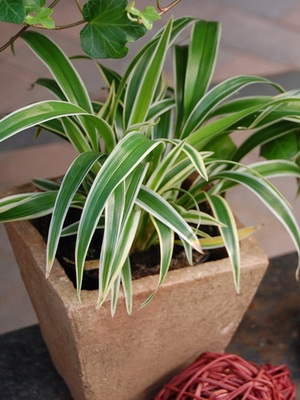


Next, you will learn how to care for chlorophytums at home and how to propagate these plants.




